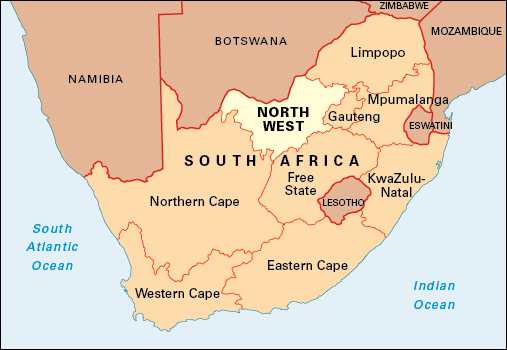North West is one of South Africa’s nine provinces. It is bordered by Botswana to the north. The province came into being on April 27, 1994. It covers an area of 40,495 square miles (104,882 square kilometers) and includes parts of the former Transvaal and Cape provinces and most of the former Black African homeland of Bophuthatswana. Mafikeng is the capital of North West. The city of Mafikeng includes Mmabatho, the former capital of Bophuthatswana.

Much of North West’s population live in rural areas. There are marked differences in standards of living between the urban and rural areas. For example, many rural people lack schools and health care facilities. Tswana (Setswana) is the most commonly spoken language in North West, followed by Sesotho, Afrikaans, and Xhosa (isiXhosa).
Economy.
Agriculture is a major economic activity in North West. The main farm products include corn, beef, sunflowers, wheat, sorghum, cotton, and peanuts. Many subsistence farmers also keep goats and sheep.
Government incentives have attracted large industries to several places in North West, especially to areas in the former Bophuthatswana. Manufactured products include automobile parts, furniture, and processed foods.
North West is rich in mineral deposits. North West is the world’s largest producer of platinum. Other minerals and substances mined include asbestos, coal, chromium, copper, diamonds, fluorite, gold, limestone, manganese, and nickel.
The Sun City entertainment complex and nearby Pilanesberg National Park are North West’s leading tourist attractions. Sun City provides employment and generates income for the province. Road and rail routes to Botswana pass through North West.
Land.
The greatest portion of North West lies on the interior plateau of southern Africa. Most of the province consists of vast, almost level plains. In the north, the remains of an ancient volcano form the Pilanesberg, which rises to 5,476 feet (1,669 meters). The continental divide, the Witwatersrand, lies in the center and east of North West. The Magaliesberg range lies north of the Witwatersrand. The Ghaap plateau lies in the southwest of the province. The vegetation of North West includes scrub, grassland, and woodland.
One of South Africa’s most important rivers, the Vaal, forms the boundary between North West and Free State. The Molopo River forms the border between Botswana and North West. Many smaller rivers in the province dry up in the winter, especially in times of drought.
History.
Hunting and gathering people inhabited the area that is North West province before the arrival of Bantu-speaking people during the A.D. 200’s. The newcomers were the ancestors of the Tswana people who live in the area today.
Mzilikazi moved the capital of his Ndebele state to the region in the early 1830’s. His forces were defeated in 1836 by the voortrekkers (advance pioneers), white Boers advancing from the south, and he left the area the following year. The Boers (Dutch farmers, later known as Afrikaners) then moved in and established Potchefstroom as their first settlement in 1838. Boer farmers gradually took over more and more territory. The South African Republic (SAR), which they established in 1858, included a considerable part of what is today North West province.
The Boers of the SAR wanted land to the west. In 1885, the British took over the land, which they called Bechuanaland, to prevent further Boer expansion westward. From this land, a small armed force invaded the SAR in 1895 in an attempt to topple the Boer government. The attempt did not succeed. During the Anglo-Boer War of 1899-1902, much of the area was fought over. A British force, with African auxiliaries, was trapped at Mafeking (now part of the city of Mafikeng) for 271 days before being relieved. See Anglo-Boer Wars.
The scattered Tswana reserves, surrounded by land farmed by white people, were granted self-government in 1971, and in 1977 became the fragmented independent bantustan (Black African homeland) of Bophuthatswana, with its capital at Mmabatho, near Mafikeng. Lucas Mangope became president of the new state, which was recognized only by South Africa and other bantustans. All Tswana-speaking Africans were then deprived of their South African citizenship, and many were forcibly removed to the new bantustan, the easternmost part of which lay on the outskirts of Pretoria. Some of the world’s largest deposits of platinum were found within the bantustan, and the region’s finances were also boosted by the tourist resort of Sun City, near Rustenburg.
The Mangope regime was authoritarian and corrupt, and resistance to it flared up in the mid-1980’s. In 1988, President Mangope was deposed in a coup, but the South African Defense Force intervened and restored him to power. From 1991, Bophuthatswana was represented at the negotiations for a democratic constitution for a reunited South Africa. Mangope opposed the reincorporation of Bophuthatswana in the new South Africa and formed an alliance with far-right white groups, including the Afrikaner Weerstandsbewiging (AWB). But in March 1994, he was forced to resign by the South African Transitional Executive Council.
The following month, the new province was formed, and the African National Congress (ANC) won a majority of seats in the new provincial legislature, which chose Mmabatho as its capital. Popo Molefe of the ANC became the first provincial premier. In 2000, the Mmabatho-Mafikeng urban area, along with nearby communities and rural areas, were merged to form the local municipality of Mafikeng. Today, the city of Mafikeng, which includes Mmabatho, is the capital of North West.
